You are using an out of date browser. It may not display this or other websites correctly.
You should upgrade or use an alternative browser.
You should upgrade or use an alternative browser.
Who shoots a fullstock Hawken flinter??
- Thread starter Southarkrob
- Start date

Help Support Muzzleloading Forum:
This site may earn a commission from merchant affiliate
links, including eBay, Amazon, and others.
paulvallandigham
Passed On
- Joined
- Jan 9, 2006
- Messages
- 17,537
- Reaction score
- 89
Please remember that the men who went to the mountains to trap Beaver were not very literate- able to read and WRITE well. Their stories were written by "reporters", often in St. Louis, when these men returned every few years to the city. Some writers traveled with supply trains to the Rendezvous in the mountains and interviews trappers there.
Reference to "Hawken " rifles may have been generalized, making them seem to be the ONLY make of gun that went out there. Certainly, the movie, "Jeremiah Johnson" which hit the Theatres in 1973, spurs lots of interest in owning "genuine Hawken rifles", so we can blame Hollywood to some extent for much of the misconceptions.
From the Histories I have read over the past 55 years or more, all kinds of guns went to and over the mountains, used by both trappers, and explorers.
Guns that weighed as much,and therefore were pretty sturdy like the Hawken rifles made in St.Louis were admired for their durability, as well as their accuracy and power. But, these are, and WERE Heavy guns. Few weighed less than 9 lbs. and most more than 11 lbs. That is a lot of gun to be carrying unless you are horseback, and can let the horse do the work for you.
I recall rifles having been made by Henry, Hawkins, and Leman being mentioned in the histories I have. But, if someone made rifles between 1820, and 1850, at least one of them went West to the Mountains in the hands of someone. :bow: Because of the Gold Rush which began in 1949, the demand for rifles and shotguns became extremely heavy, and jump off places, like St. Louis, and St. Joseph, Missouri, Could, and did, sell just about any brand of rifle or shotgun made. All the Eastern Gun makers either moved West( Sam and Jake Hawkins moved their shop from Pennsylvania, to St. Louis) or arranged to have dealers sell their guns out there, with some guns becoming very common out West before they were available in the East.
Reference to "Hawken " rifles may have been generalized, making them seem to be the ONLY make of gun that went out there. Certainly, the movie, "Jeremiah Johnson" which hit the Theatres in 1973, spurs lots of interest in owning "genuine Hawken rifles", so we can blame Hollywood to some extent for much of the misconceptions.
From the Histories I have read over the past 55 years or more, all kinds of guns went to and over the mountains, used by both trappers, and explorers.
Guns that weighed as much,and therefore were pretty sturdy like the Hawken rifles made in St.Louis were admired for their durability, as well as their accuracy and power. But, these are, and WERE Heavy guns. Few weighed less than 9 lbs. and most more than 11 lbs. That is a lot of gun to be carrying unless you are horseback, and can let the horse do the work for you.
I recall rifles having been made by Henry, Hawkins, and Leman being mentioned in the histories I have. But, if someone made rifles between 1820, and 1850, at least one of them went West to the Mountains in the hands of someone. :bow: Because of the Gold Rush which began in 1949, the demand for rifles and shotguns became extremely heavy, and jump off places, like St. Louis, and St. Joseph, Missouri, Could, and did, sell just about any brand of rifle or shotgun made. All the Eastern Gun makers either moved West( Sam and Jake Hawkins moved their shop from Pennsylvania, to St. Louis) or arranged to have dealers sell their guns out there, with some guns becoming very common out West before they were available in the East.
- Joined
- Mar 17, 2010
- Messages
- 1,372
- Reaction score
- 42
Nice looking Flinter, I like the tacks and the file marks, If those on the barrel are all confirmed deer kills, you've done your part making the roads safer to travel.
Snakebite
45 Cal.
Personally I thought LaBonte's info was pretty good, pretty well laid out. I do not think the men in the fur trade were so ignorant that they generalized their rifles as being Hawkens unless they were made my Jake or Sam Hawken. And if they did, it was because Hawkens must have been pretty well sought after. Regardless, I'm sure they knew whether their rifle was a Wheeler or Henry or Deringer or Leman or whom ever made it. And regardless of their ability or read or write, I'd be willing to bet they knew what their equipment was. Especially something so important as their rifles.
Personally I like Hawkens, I like the big bore, I like the sturdiness of them and I like the lines. I've heard some describe them as big thick fence posts, IMO, nothing could be further from the truth. I've seen originals up close and I think there is a grace and beauty there just as there is in a Lancaster or York or many of the other Eastern rifles. In another topic it went on and on about how heavy they were and they wouldn't have been carried except on horseback. IMO, those guys in the mountains were pretty tough. If they had to walk, I'd bet they carried their Hawken, or Leman or whatever rifle they had and not think twice about it.
Again, LaBonte, thanks for the info.
And Stubert, nice rifle.
Personally I like Hawkens, I like the big bore, I like the sturdiness of them and I like the lines. I've heard some describe them as big thick fence posts, IMO, nothing could be further from the truth. I've seen originals up close and I think there is a grace and beauty there just as there is in a Lancaster or York or many of the other Eastern rifles. In another topic it went on and on about how heavy they were and they wouldn't have been carried except on horseback. IMO, those guys in the mountains were pretty tough. If they had to walk, I'd bet they carried their Hawken, or Leman or whatever rifle they had and not think twice about it.
Again, LaBonte, thanks for the info.
And Stubert, nice rifle.
Don King made a lot of them.Southarkrob said:I have been looking at the fullstock Hawken flint rifles. Do many people shoot them? Do you have any pics of them? Thanks Robbie
He made almost all the parts and stocked them from blanks.
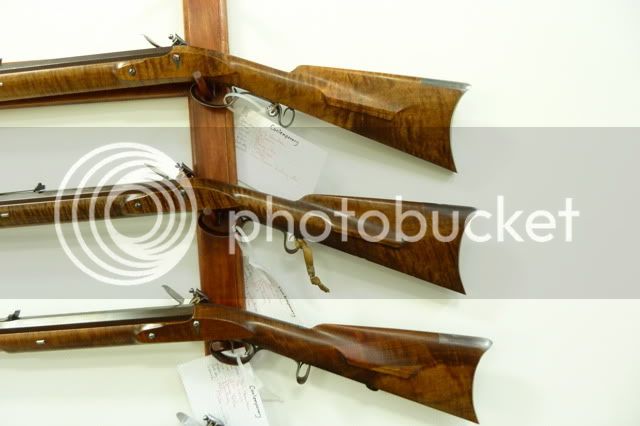
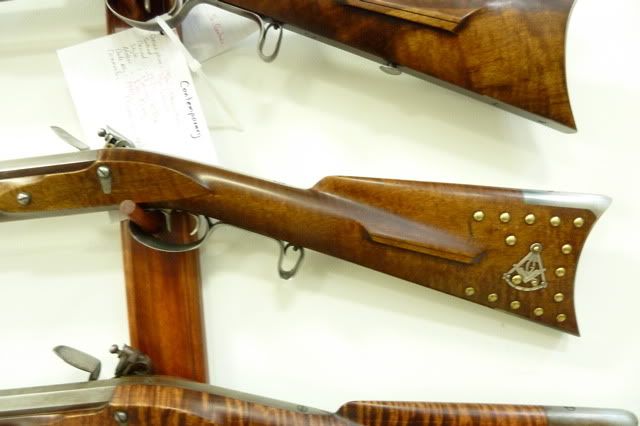
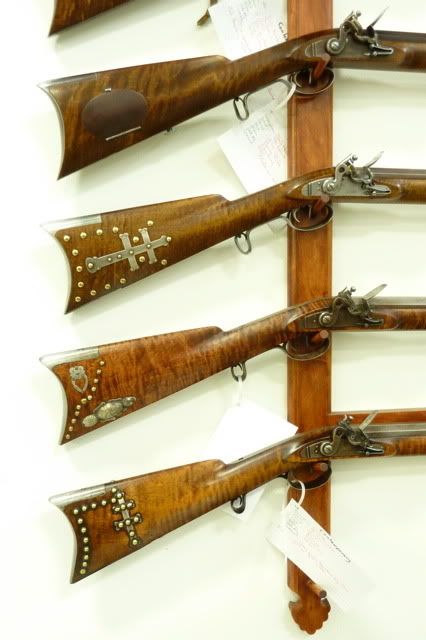
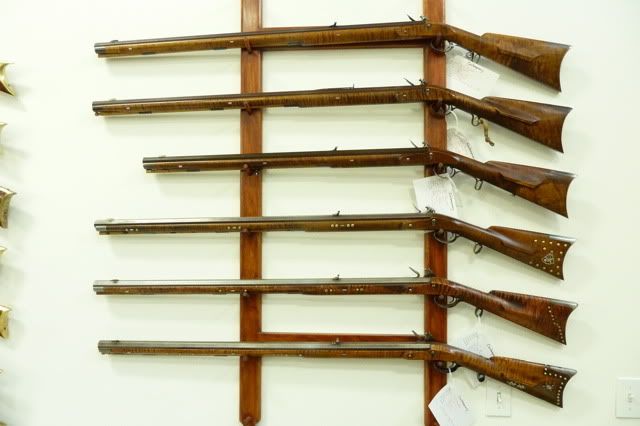

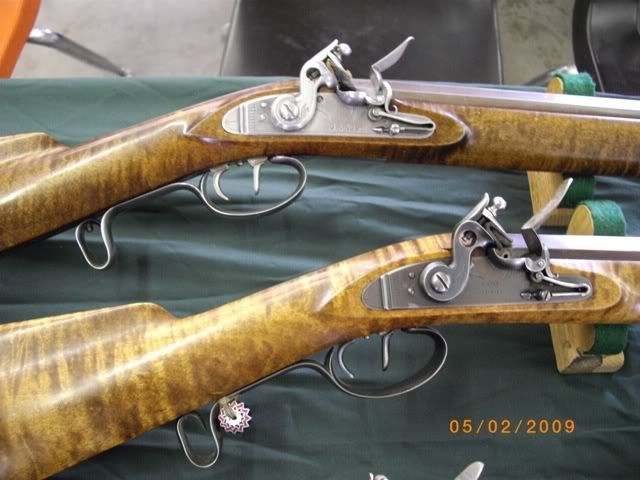
I own one of the rifles in the display and have used it extensively.
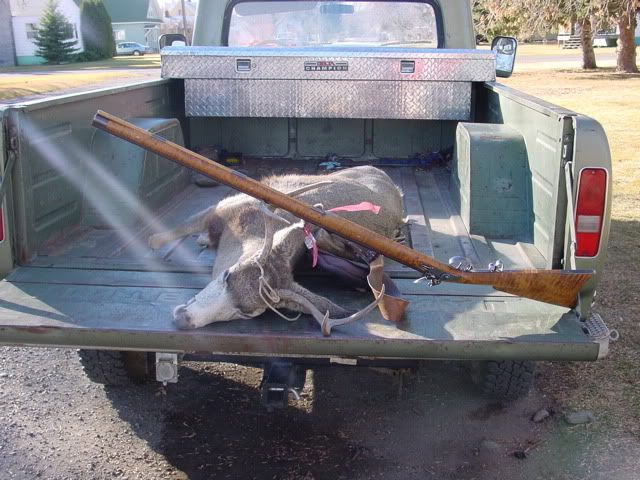
He made pistols to go with them too.
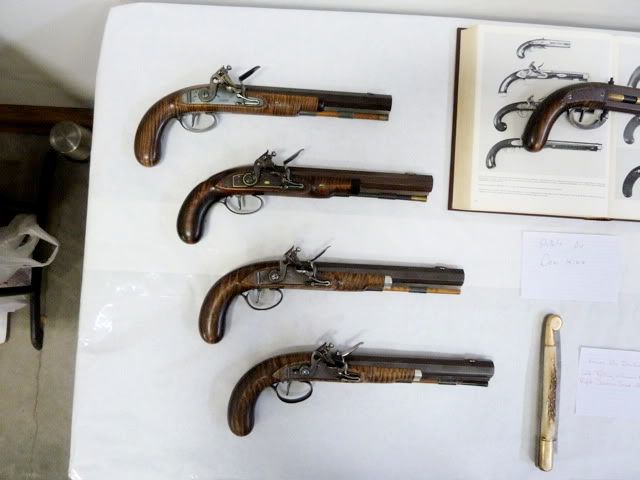
And other things as well
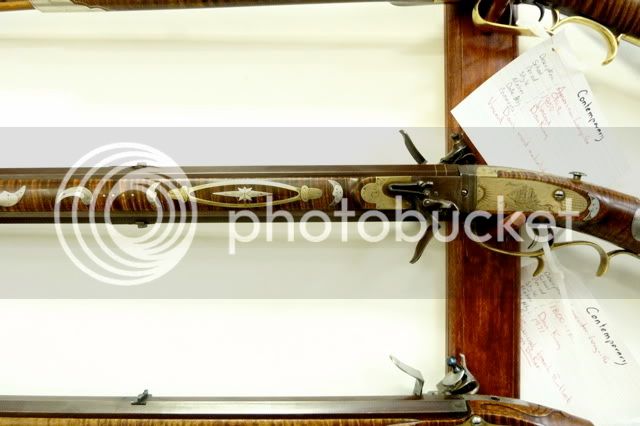
Most of the photos here are from the 2010 Montana Historical Gunmakers Guild Fair.
Dan
There are some other quotes that need to be considered. Not EVERYONE in the west was enthused with the percussion cap.
March 1830 Ramsey Crooks to J.J. Henry.
" ...hasten to inform you that Percussion Locks will not answer at all for the rifles..."
In 1841 John Bidwell emigrated to Calif. "my gun was a old flint-lock rifle, but a good one. Old hunters told me to have nothing to do with cap or percussion locks, that they were unreliable..."
James J. Webb acquired a rifle in 1845
"...Many years before, a trapper employed by the American Fur Company had taken it on a trapping expedition in the Blackfoot country. The Indians killed him and took his gun. Years after Messrs Bent St Vrain and Company sent an expedition to that nation on a trapping and trading trip and trade for the old rifle. At the fort it was restocked (full length), and altered from flint-lock to percussion, and kept at the fort for a target rifle for several years. In 1846 I had it newly grooved [rifled], half stocked and [added] a new lock and breech pin, and have carried it in all my travels... In 1849 a man from Boonville, Missouri, on his way to California, came into the store when I was cleaning it up, and on looking at it, said: 'My father made that gun. There are his initials. It must be very old for he has been dead many years and did not work of that for many of the last years of his life..."
These quotes are all from "Firearms of the American West 1803-1865" pg 42-50.
While Garavaglia and Worman have no axe to grind they conclude on pg 42
"Because of the flintlock's longevity in the West there is a strong probability that the Hawken shop continued to turn out flintlocks well into the 1830s. Available evidence indicates that the Hawken brothers may have made a few percussion arms even in the late 1820s, but these were almost certainly in the minority until the mid-1830s."
pg 43
"By the mid-1830s the advantages of the percussion system were becoming apparent to a respectable number of the plains-rifle buyers, an probabilities are that at that time there were at least as many percussion arms coming out of the Hawken shop as flintlocks."
Shotguns vs rifles.
Nigel George tells us in "English Guns and Rifles" that in England the percussion system swept the flintlock from the field almost overnight in SHOTGUNS but that the flintlock hung on longer in rifles even in England.
It is entirely possible that variations in the strength of the percussion cap, the early nipple or breech designs may have caused accuracy problems with percussion rifles early on.
The shotguns used for wing shooting switched because the percussion shotgun is far easier hit flying targets with than the flintlock.
I suggest that people wanting to inform themselves should see if they can obtain a copy of "Firearms of The American West 1803-1865" and the followup volume too is later firearms are of interest.
While out of print it can still be found and it may be available through inter-library loan.
Then its possible to read the information in its complete form and check the extensive list of references.
Dan
March 1830 Ramsey Crooks to J.J. Henry.
" ...hasten to inform you that Percussion Locks will not answer at all for the rifles..."
In 1841 John Bidwell emigrated to Calif. "my gun was a old flint-lock rifle, but a good one. Old hunters told me to have nothing to do with cap or percussion locks, that they were unreliable..."
James J. Webb acquired a rifle in 1845
"...Many years before, a trapper employed by the American Fur Company had taken it on a trapping expedition in the Blackfoot country. The Indians killed him and took his gun. Years after Messrs Bent St Vrain and Company sent an expedition to that nation on a trapping and trading trip and trade for the old rifle. At the fort it was restocked (full length), and altered from flint-lock to percussion, and kept at the fort for a target rifle for several years. In 1846 I had it newly grooved [rifled], half stocked and [added] a new lock and breech pin, and have carried it in all my travels... In 1849 a man from Boonville, Missouri, on his way to California, came into the store when I was cleaning it up, and on looking at it, said: 'My father made that gun. There are his initials. It must be very old for he has been dead many years and did not work of that for many of the last years of his life..."
These quotes are all from "Firearms of the American West 1803-1865" pg 42-50.
While Garavaglia and Worman have no axe to grind they conclude on pg 42
"Because of the flintlock's longevity in the West there is a strong probability that the Hawken shop continued to turn out flintlocks well into the 1830s. Available evidence indicates that the Hawken brothers may have made a few percussion arms even in the late 1820s, but these were almost certainly in the minority until the mid-1830s."
pg 43
"By the mid-1830s the advantages of the percussion system were becoming apparent to a respectable number of the plains-rifle buyers, an probabilities are that at that time there were at least as many percussion arms coming out of the Hawken shop as flintlocks."
Shotguns vs rifles.
Nigel George tells us in "English Guns and Rifles" that in England the percussion system swept the flintlock from the field almost overnight in SHOTGUNS but that the flintlock hung on longer in rifles even in England.
It is entirely possible that variations in the strength of the percussion cap, the early nipple or breech designs may have caused accuracy problems with percussion rifles early on.
The shotguns used for wing shooting switched because the percussion shotgun is far easier hit flying targets with than the flintlock.
I suggest that people wanting to inform themselves should see if they can obtain a copy of "Firearms of The American West 1803-1865" and the followup volume too is later firearms are of interest.
While out of print it can still be found and it may be available through inter-library loan.
Then its possible to read the information in its complete form and check the extensive list of references.
Dan
Southarkrob
40 Cal.
- Joined
- Jun 14, 2011
- Messages
- 129
- Reaction score
- 1
Thanks Dan for the pics...those are some beautiful rifles. I love the inlays on some of them. Robbie
p.s. nice buck in the back of your truck..is that an International?? 4x4??? thanks Rob
p.s. nice buck in the back of your truck..is that an International?? 4x4??? thanks Rob
Southarkrob said:Thanks Dan for the pics...those are some beautiful rifles. I love the inlays on some of them. Robbie
p.s. nice buck in the back of your truck..is that an International?? 4x4??? thanks Rob
Its 1974. Still have it but its going to find another home one way or another. Have a 1975 and a 66 too.
Dan
paulvallandigham
Passed On
- Joined
- Jan 9, 2006
- Messages
- 17,537
- Reaction score
- 89
I also believe that LaBonte's information is top notch. :hatsoff:
My only point is that much of our information from these men was written years later, by reporters and writers plying the old men with liquor in taverns in St. Louis, and other forts and towns. Reporters rarely actually traveled to the mountains with the mountain men to learn the information first hand. Whatever details they didn't get from the men involved, they made up. Ned Buntline was not the first "writer" of this kind. Earlier writers made up all kinds of stuff about people like Davy Crockett, Daniel Boone, Simon Girty, and Andrew Jackson.
The Hawken rifle WAS impressive, to everyone who saw or held one. Its very easy to understand that writers would use that name instead of the actual name of the firearm maker whose gun went west with the mountain men. There were Hundreds of trappers, sponsored by several competing Fur Companies, both American and British.
The Hawkin brothers may have made hundreds of rifles over the life of their shop, but certainly were not producing enough guns annually to supply all the hunters and trappers, and explorers who went West in any given year.
We have the idea of the LONE Trapper, ala Jeremiah Johnson( the movie). The truth is that most trappers worked as groups( brigades) for self defense. They didn't need the Best rifles- and lesser(cheaper) guns than the Hawkin's rifles were purchased and used.
It took some time before the quality of percussion caps became reliable enough to be used by these men. The ignition system goes back to the 1820s, but it wasn't until the late 1840s that the priming compound was changed, and some way of water proofing the caps was made to convince shooters to buy those guns. :surrender: :thumbsup:
My only point is that much of our information from these men was written years later, by reporters and writers plying the old men with liquor in taverns in St. Louis, and other forts and towns. Reporters rarely actually traveled to the mountains with the mountain men to learn the information first hand. Whatever details they didn't get from the men involved, they made up. Ned Buntline was not the first "writer" of this kind. Earlier writers made up all kinds of stuff about people like Davy Crockett, Daniel Boone, Simon Girty, and Andrew Jackson.
The Hawken rifle WAS impressive, to everyone who saw or held one. Its very easy to understand that writers would use that name instead of the actual name of the firearm maker whose gun went west with the mountain men. There were Hundreds of trappers, sponsored by several competing Fur Companies, both American and British.
The Hawkin brothers may have made hundreds of rifles over the life of their shop, but certainly were not producing enough guns annually to supply all the hunters and trappers, and explorers who went West in any given year.
We have the idea of the LONE Trapper, ala Jeremiah Johnson( the movie). The truth is that most trappers worked as groups( brigades) for self defense. They didn't need the Best rifles- and lesser(cheaper) guns than the Hawkin's rifles were purchased and used.
It took some time before the quality of percussion caps became reliable enough to be used by these men. The ignition system goes back to the 1820s, but it wasn't until the late 1840s that the priming compound was changed, and some way of water proofing the caps was made to convince shooters to buy those guns. :surrender: :thumbsup:
Southarkrob
40 Cal.
- Joined
- Jun 14, 2011
- Messages
- 129
- Reaction score
- 1
I thought it was...luv them oold internationals...i remember squirrel hunting as a kid behind my dads old homeplace and found a 50's (I think) International parked in the woods with a tree growing out the bed...it was my grandpas that he had parked there years ago.
Fullstock58
40 Cal.
- Joined
- Mar 4, 2007
- Messages
- 179
- Reaction score
- 0
My fullstock hawk is the 4th gun down, it was built by me in around 1988, it is 58cal, and I chose the 58 because of two reasons, the first was it was going to be an Elk rifle, so the big 58cal ball has lots of down range energy, plus it would bring the weight down slightly toting it in the mountains, second was the 58cal in Lymans blackpowder book never got out of the LUP range, so that was a plus.
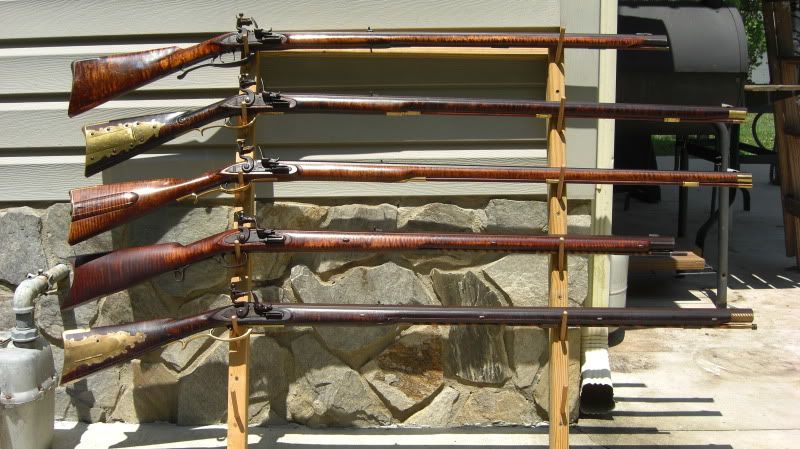

Southarkrob
40 Cal.
- Joined
- Jun 14, 2011
- Messages
- 129
- Reaction score
- 1
Fullstock...that is a mity nice rack of rifles...are they all yours???
Fullstock58
40 Cal.
- Joined
- Mar 4, 2007
- Messages
- 179
- Reaction score
- 0
yes they are, I do have a fondness for fullstock rocklocks!
Similar threads
- Locked
- Replies
- 1
- Views
- 130
- Replies
- 154
- Views
- 5K







